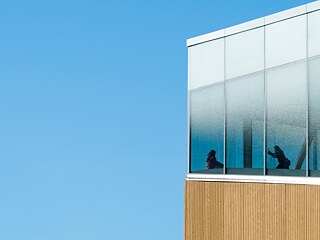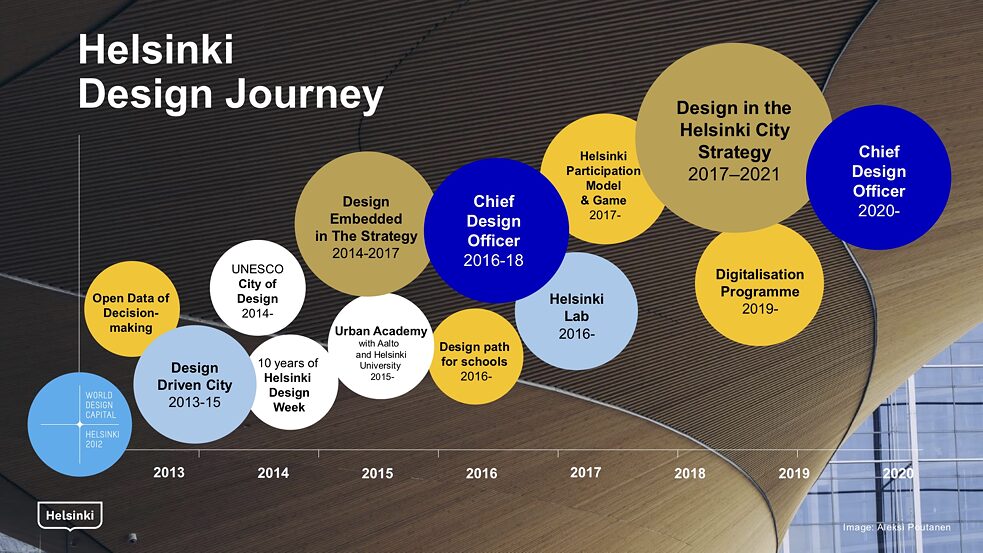
Helsinki Designs Better Life
By Päivi HietanenThe City of Helsinki, the capital of Finland, is a municipality of 600 000 residents. The responsibilities of cities in Finland include a wide range of tasks from transportation to hospitals and schools. Thus, the City of Helsinki is one of the largest organizations of the country with around 38 000 employees.
In Helsinki, design has been an integral part of the city’s development for more than ten years. In the year 2012, Helsinki was designated as World Design Capital and later UNESCO City of Design. In 2016, City of Helsinki became one of the first capitals to appoint a Chief Design Officer. Design thinking and a human-centered approach have been strongly embedded in City strategies. One of the key design activities was the development of the Helsinki participation model 2017 and the piloting of participatory budgeting together with the residents. Currently there is a strong and increasing focus in design activities that support digital development.
One of the milestones in Helsinki’s design journey has been setting up an internal design team, Helsinki Lab. Based in the central administration, the Lab promotes design thinking within the city organization. It helps city divisions to develop their services and service environments, digital solutions and customer experience and also to manage the related cultural change. The vision of the Lab is to combine design, digitalization and dialogue to create a better city together with the citizens.
The Lab offers city staff expertise in managing design projects and procuring design services. By organizing design events, sharing best practices and offering service design training and peer support, the Lab creates a platform for city developers to share knowledge and to learn. The Lab also facilitates citywide design processes that aim at tackling complex societal issues like immobility of elderly people, labor shortage or social exclusion of youth.
Design creates value for Helsinki in many ways. First of all, design helps the city understand people's daily lives and needs. It is a powerful tool to improve customer experience by producing better services and built environment and engaging citizens in their development. Another focus area is employee experience. Design is not only a method to develop better services but the way to renew the organization and its operating culture, too. Thirdly, design is viewed as a powerful brand factor; it is the way for Helsinki to stand out.
Design is for Helsinki a way to build the world's most functional city. Most importantly, it is a tool for solving meaningful problems and major global challenges of our times.
In Helsinki, design has been an integral part of the city’s development for more than ten years. In the year 2012, Helsinki was designated as World Design Capital and later UNESCO City of Design. In 2016, City of Helsinki became one of the first capitals to appoint a Chief Design Officer. Design thinking and a human-centered approach have been strongly embedded in City strategies. One of the key design activities was the development of the Helsinki participation model 2017 and the piloting of participatory budgeting together with the residents. Currently there is a strong and increasing focus in design activities that support digital development.
One of the milestones in Helsinki’s design journey has been setting up an internal design team, Helsinki Lab. Based in the central administration, the Lab promotes design thinking within the city organization. It helps city divisions to develop their services and service environments, digital solutions and customer experience and also to manage the related cultural change. The vision of the Lab is to combine design, digitalization and dialogue to create a better city together with the citizens.
The Lab offers city staff expertise in managing design projects and procuring design services. By organizing design events, sharing best practices and offering service design training and peer support, the Lab creates a platform for city developers to share knowledge and to learn. The Lab also facilitates citywide design processes that aim at tackling complex societal issues like immobility of elderly people, labor shortage or social exclusion of youth.
Design creates value for Helsinki in many ways. First of all, design helps the city understand people's daily lives and needs. It is a powerful tool to improve customer experience by producing better services and built environment and engaging citizens in their development. Another focus area is employee experience. Design is not only a method to develop better services but the way to renew the organization and its operating culture, too. Thirdly, design is viewed as a powerful brand factor; it is the way for Helsinki to stand out.
Design is for Helsinki a way to build the world's most functional city. Most importantly, it is a tool for solving meaningful problems and major global challenges of our times.
